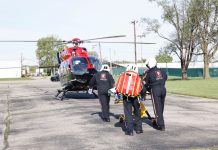The first of two new high-intensity pedestrian activated walk (HAWK) signals was installed last week at Fifth and Lindsey streets to make it safer for downtown walkers to get into Mill Race Park.
But since off-duty officers were present to guide patrons of last Saturday’s Columbus Craft Beerfest across the busy street, few walkers needed to try out the new gadgetry.
As both motorists and pedestrians get used to the new crossings, off-duty officers will continue to be used for pedestrian safety during big events at the park, said Dave Hayward, executive director of public works and city engineer.
That includes tonight’s Our Hospice of South Central Indiana free concert, which starts at 6:30 p.m. and brings out headliner Peter Cetera at 8 p.m.
[sc:text-divider text-divider-title=”Story continues below gallery” ]
However, discussions have begun between local police and the city engineer’s office on whether the HAWK signals will be sufficient to keep walkers safe at smaller Mill Race events, Hayward said.
The second HAWK signal — on Brown Street, between 5th and 8th Streets — should be operational before the end of October, Hayward said.
For walkers and bicyclists, the new signals appear no different than at several other major pedestrian crossings.
But for drivers, “there will definitely be a learning curve,” Hayward said.
Although motorists will see red, yellow and green signals provide the same messages they do at other intersections, most won’t be accustomed to the sequences in which those signals are given, the city engineer said.
If there are no pedestrians pushing the crosswalk button, the HAWK crossing remains dark. But once activated, approaching motorists will see a progression of four signals.
» Flashing yellow: Proceed with caution.
» Solid yellow: Prepare to stop
» Solid red: Stop to allow pedestrians to cross.
» Flashing red: Proceed after checking to make sure no more walkers are present.
Records show that of the three accidents reported at Fifth and Lindsey streets during the past two years, none have involved pedestrians or bicyclists, Columbus Police spokesman Lt. Matt Harris said.
However, those records do not reflect the several close calls that makes walking across Lindsey or Brown “feel like a game of Frogger,” as one Cummins employee described it.
In 2013, the local manufacturer reported that seven of its downtown employees narrowly escaped being hit by a passing vehicle. That number increased to 12 in 2014 and to 15 last year.
“When you walk out across the third lane, they don’t see you,” Cummins employee Jodie Coomer said. “I’ve had cars sneak up and whip out in front of me.”
The company has seven downtown locations where about 3,500 employees work.
As Ron Chapman was about to cross Brown Street to enter the Cummins corporate office building, the service director said he believes what’s really needed is more common sense by both pedestrians and motorists.
“But sometimes, drivers don’t stop like they should,” Chapman said. “They just come right on through, and at times, it gets a little dangerous.”
Will the new pedestrian crossings help? Coomer said she is skeptical, while Chapman said he is taking a wait-and-set approach.
HAWK signals were first developed in the 1990s specifically for high-speed or wide-crossing conditions, in order to give drivers multiple cues about the potential presence of pedestrians.
Studies show it is able to reduce pedestrian accidents by 69 percent, with a 29 percent reduction in total crashes, according to the Federal Highway Administration.
Meanwhile, Cummins safety experts are working to install rectangular rapid-flashing beacons in other areas along Brown and Jackson streets, Hayward said.
Utilizing an irregular flash pattern similar to what is used on emergency vehicles, RRFBs show an 88 percent compliance rate of drivers yielding to pedestrians, compared to 18 percent when standard crossing signs are installed, federal studies show.
If the HAWK signals are determined to be effective in the downtown area, they may be considered in other areas such as Washington Street near Noblitt Park and 25th Street near Lincoln Park, Hayward said.
But for now, no funding has been set aside and no plans are on the drawing board for additional HAWK signals, he said.
[sc:pullout-title pullout-title=”More safety improvements ” ][sc:pullout-text-begin]
New HAWK pedestrian crossing signals near Mill Race Park are just one of many steps being either implemented or considered to improve safety for walkers and bicyclists.
Additional pedestrian crossings are being installed on Jackson Street, where it intersects with Sixth and Seventh streets. Curbs will be extended and bumped out at the new crosswalks on the west side of the street that runs along the front entrance of the Cummins Corporate Office Building.
As part of a traffic plan, Cummins is proposing that:
- Three lanes on Brown Street, between Third and Eighth streets, be reduced to two lanes.
- A reduction in the 35 mph speed limit along Brown.
In May, the Columbus City Council approved an ordinance change to allow a portion of Second Street outside the parking garage to be converted from one-way traffic to two-way.
The Columbus Board of Works has also approved an agreement that will allow Cummins to install fencing along the Brown Street sidewalks to discourage pedestrians from jaywalking.
[sc:pullout-text-end]




